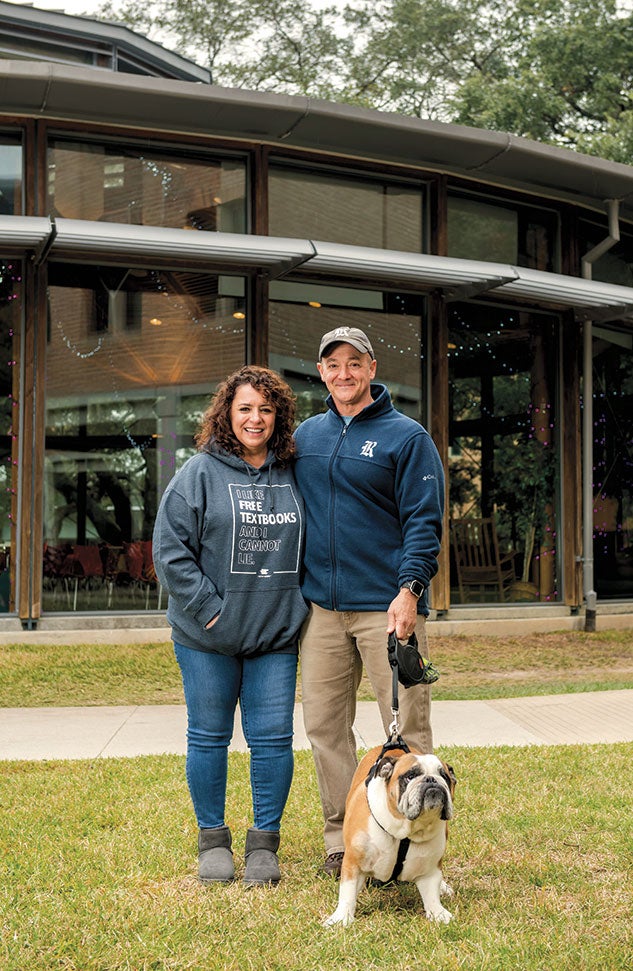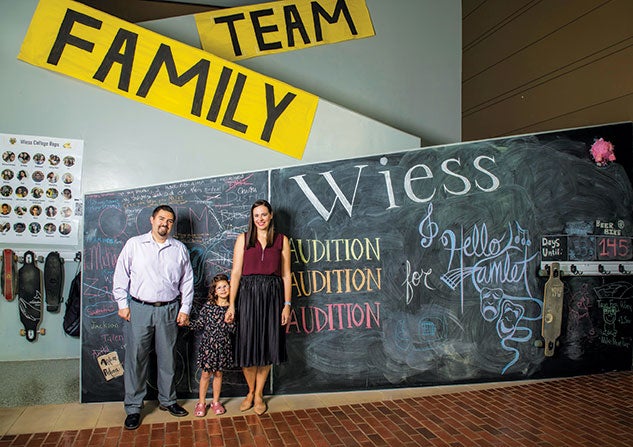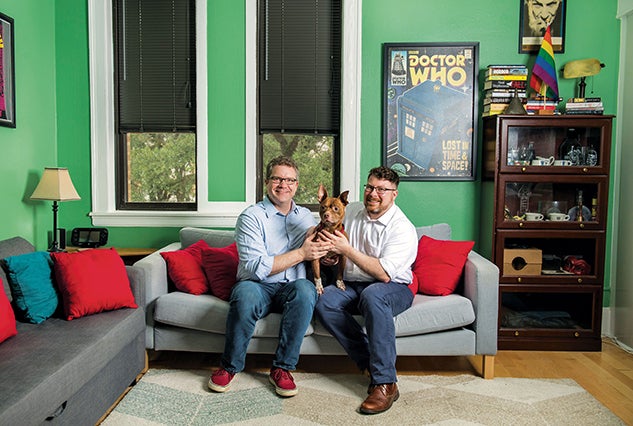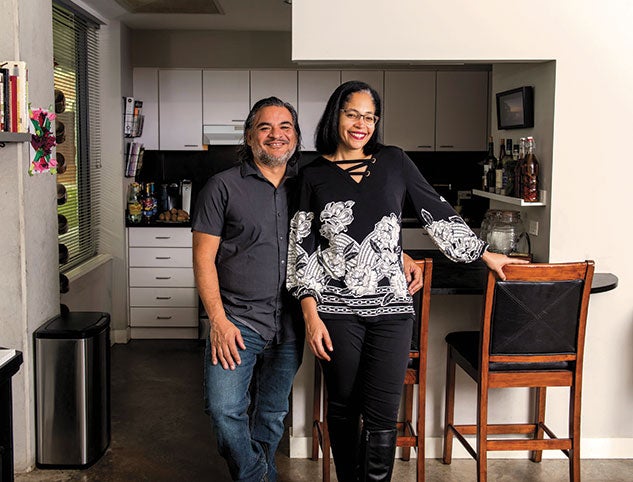Where Students Become Family
RAs are key to Rice’s strong residential college system, helping to make each college feel like home for students.
By Jenny West Rozelle
RAs. For anyone who didn’t attend Rice, those letters often bring to mind an upperclassman whose job it is to police the hallways and catch fellow students in the act of breaking regulations.
But not at Rice. RAs, or resident associates, are full-time staff or faculty members who often have partners, spouses, children and/or pets. They have gone through an intensely competitive application process — including a written application, formal interviews with students and the magisters, informal meetings at meals and college events, and final approval from the dean of undergraduates — in order to volunteer for up to a seven-year term. RAs host study breaks and help with planning college events. They eat their meals with the students in the commons and live among the undergraduates in apartments that, much like the colleges themselves, vary widely in size and layout based on the architecture of the building. They are mentors — offering academic advising, a real-world perspective on careers and life skills, and an understanding of other university resources available to students.
Most importantly, they form relationships with the members of their college. While at Rice, students may be faced with issues such as the death of a family member, their own serious illness or failing grades. When RAs become a familiar face at the college, hopefully students feel comfortable coming to them when they need assistance, explained Dean of Undergraduates Bridget Gorman, whose office oversees the RA program.
“They are the ones who are there when something happens in the middle of the night,” Gorman said. “They’re the ones who are residing in the buildings alongside students. In some ways, that makes it a more personal relationship, and they can serve as a key resource for our students.” Gorman, who was an RA at Jones College (2004–2008) and then a magister at Will Rice College (2011–2018) in addition to being a professor of sociology, added that she thinks of RAs as the cool aunts and uncles of the college.
RAs are not alone in shouldering these responsibilities. The core team at each college includes a set of magisters, two or three sets of RAs, and a college coordinator. At Duncan and McMurtry colleges, the third set of RAs are referred to as head resident fellows (HRFs), a position originally created to add another layer of support to the two largest colleges. Core teams meet frequently and discuss issues from how to assist students in crisis to how best to support the student leadership.
Ideally, colleges come to feel like a family instead of simply an academic establishment. Let’s meet some of the family members.

Brian Gibson and Alana Lemay-Gibson
Sixth-year McMurtry College HRFs Martel College RAs, 2004–2011
Sid Richardson College RAs, 1996–2004
After 20 years on campus, Brian Gibson and Alana Lemay-Gibson know the RA role inside and out. After stints at Sid Richardson and Martel colleges, followed by a few years off, they were chosen as HRFs at McMurtry College in 2014.
“McMurtry and Duncan are very big colleges with respect to the others, so it took some time to figure out how to try to get to know more than 400 people,” said Gibson, the senior associate dean of undergraduates and a clinical professor of kinesiology. Regardless, “It’s an amazing experience to live with so many interesting and talented students.”
At each college where they have been members, they have established a number of activities. Lemay-Gibson introduced Senior Beer Tasting at Sid Richardson, Martel and now McMurtry. They launched Oktoberfest at Martel and McScottish Night at McMurtry, both of which are events that celebrate the entire college community. Gibson has coached powderpuff at all three colleges, and all won championships during his tenure. It’s one of his favorite ways to share a passion for football and teaching while getting to know the students.
“We’ve now worked with 10 different RA couples or single RAs, and each has brought a different set of interests and ideas to the position,” said Lemay-Gibson, the director of project management at OpenStax, a nonprofit educational initiative at Rice that publishes free online and low-cost print textbooks and offers research-based courseware. “It’s fun to see how effective people can be while doing things very differently.”
Some of the best aspects about being RAs include “being a part of a larger community and feeling like you can have a positive impact on students who have so much potential,” said Gibson. “The RA system has structure and expectations, but it also allows the freedom to be creative and engage in ways that are rewarding and meaningful.”

Carissa Zimmerman and Nick Espinosa
Second-year Wiess College RAs
Carissa Zimmerman, Nick Espinosa and their 5-year-old daughter, Amelia, truly live their college’s motto: Team Family Wiess. When they are in their apartment at the college, they have the shades open and welcome students dropping by any time. “Amelia loves Sunday morning pancakes, so we cook a big pancake breakfast twice a month and encourage students to come eat with us in our apartment. Having Wiessmen eat pancakes and play with her is one of the things that Amelia looks forward to on the weekends,” said Zimmerman, a senior lecturer of psychological sciences. “But really I think the students are the ones who have made it a priority to include her, which is amazing.
Espinosa, who is a project manager and engineer at Jacobs, a subcontractor to NASA, is often not around Rice during business hours. “It’s a challenge to balance the extra responsibilities with our family and job responsibilities,” he said. “But at the same time, I do think I can offer a different perspective. I’m a practicing engineer, so I’m able to give some advice for nonacademic careers. I’ve also given some interview advice and shared stories with students. I think it’s good for students to see how older people who aren’t their parents navigate their own lives.”
“I’ve always strongly believed that college is not only a time for academic learning, although that’s important, but also a time for personal growth and social development,” said Zimmerman. This year, they’re starting an “Adulting 101” series that will include topics such as how to do taxes, how to choose and apply for a credit card, and how to rent an apartment or buy a house. Fortunately, the students already demonstrate quite a bit of maturity. Espinosa said, “I was expecting that we’d be dealing with more rambunctiousness from the students and perhaps more minor trouble due to age and alcohol. But overall, Rice students are really mature and impressive.”

William Edmond
First-year Sid Richardson College RA
William Edmond has had this role before — and yet he hasn’t. Edmond came to Rice after working in higher education student affairs at The Ohio State University, where he also lived on campus with undergraduates. When he was first approached about applying to become an RA at Rice, he thought he knew the job description. “I thought it would be something where you’re supervising student staff and running staff meetings and the hall council,” he said. He asked if he would have all those responsibilities in addition to his job as assistant director of Rice’s Office of Multicultural Affairs and was surprised when students told him that RAs at Rice have none of those tasks. “It’s completely different from what I did at Ohio State.”
“Students really value the relationships and mentorship offered by the whole Senior Sidizens team [the college’s core team],” Edmond said. “They want you to be a part of everything — from coaching sports teams to attending musical performances. They really trust you, they look to you as a mentor, and they want to share their college experience and things that are special to them.”
Because of his lifelong love of sports, Edmond predicts that one way he will participate in Sid Rich activities is through athletics, whether coaching powderpuff, playing on intramural teams or attending events. “Students sometimes forget that RAs have a job and a life and friends outside the college,” he said. “For me, it’s a balancing act of how much can I give of myself, where do I set a boundary, what kind of programming can I offer that would be valuable to them and also align with my interests, and how do I do this in a way that fosters relationships.”

Bobby Beaird and Matt Patterson
Third-year Baker College RAs
Students love to eat. Fortunately, Bobby Beaird and Matt Patterson ’07 love to cook.
Beaird and Patterson met during graduate school at LSU in Baton Rouge and enjoy sharing the flavors of Louisiana with others. When they applied to be RAs at Baker College, one of their “campaign promises” was to make jambalaya for students if they could acquire a cast-iron pot. During their first O-Week, some parents from south Louisiana heard about that wish and helped them find a 16-gallon cast-iron pot, which has enabled them to make jambalaya for 60–70 people at a time. “Even Louisiana students say it’s tasty. And students who have never had it before come back for thirds,” said Beaird.
They do smaller-scale events regularly too, such as “Star Trek” TV show viewings and video game evenings. “The point of games like that is to get people together — to do something that’s fun,” said Patterson, a licensing associate in Rice’s Office of Technology Transfer. “It gets them out of their heads for an hour or so.”
Patterson and Beaird believe that, as RAs, their primary goal is to be as present as possible. “It helps to know that there are adults who are around who actually care what’s going on with you,” said Patterson. “That kind of presence was valuable for me when I was a student [at Jones College].”
RAs are “the ones who will ask you to think about things but will not turn around and judge you and make you feel bad for being in a position where you needed help,” said Beaird, an instructor of physics and astronomy. “People are willing to wake us up at 2 or 3 a.m. to have necessary conversations that we’d rather handle in the moment instead of having a student sit and suffer in silence. I like that we’re not in the role of being rule enforcers. I want to be there and help support students when they need it.”

Jenifer Bratter and Noe Perez
Fifth-year Duncan College HRFs (and newly appointed McMurtry College magisters!)
It’s not often that students are encouraged to punch members of their college core team. But that’s one of the many ways that Noe Perez has found to connect — quite literally — with students at Duncan College. During final exams, Perez and one of his fellow RAs don padding and let students punch away, while Jenifer Bratter and other core team members bring out snacks and talk with stressed-out students.
Being an accessible and visible presence in Duncan has been an integral part of the HRF role for Bratter and Perez. They also have gotten to know Duncan members through their sons and have been able to fold some of their boys’ favorite hobbies into events they hold for the college, such as “American Ninja Warrior”-style obstacle courses with Ricardo, who is 14, and guitar jams with Sam, who is 9.
Bratter and Perez have noticed that students enjoy bonding with Ricardo and Sam over meals in the commons and other activities. “I think either because they miss their siblings or because interacting with children is different from interacting with us, it feels like the students get a lot out of it,” observed Bratter, a professor of sociology and director of Building Research on Inequality and Diversity to Grow Equity, also known as BRIDGE.
“Rice’s RA system really does seem to capture the desire to make these colleges homes and make people family,” she added. “The RA and HRF roles allow students to interact with parties at the university in a way that is purely about relationships and community.”
“I feel like we’ve been able to help students who have gone through some pretty serious things,” said Perez, who formerly worked as a data research specialist at Rice’s Houston Education Research Consortium and now volunteers in the community and at their sons’ school. “When there’s a student we’ve helped who brings another student to the door, that really makes us feel like, yes, this is why we’re here. That’s the part that matters the most.”
